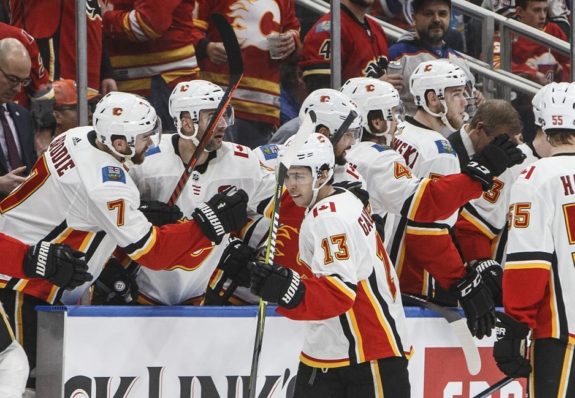The 2017-18 National Hockey League season began with great expectations for the Calgary Flames. Those expectations were dashed, as the Flames finished 11 points outside of a playoff spot. While the 2018-19 season began with more tempered expectations, it’s safe to say that the Flames have overshot those expectations as they sit second overall through the All-Star Break.

But given the lowered expectations for the club heading into the season, a few key things had to turn out favourably for the Flames for them to plot their present course. Here are four key developments that put the Flames on a path to being an unlikely NHL powerhouse.
Proper Slotting on the Blue Line
Revamping the Flames’ defensive group has been the bane of Brad Treliving’s existence since he became general manager in 2014. He’s made big trades and a lot of minor tweaks to try to get a proper balance of speed, skill, experience and physicality. For years the top pairing of Mark Giordano and either Dougie Hamilton or TJ Brodie worked well, but basically no other tandem found success. The acquisition of Travis Hamonic at the 2017 NHL Draft and Noah Hanifin at the 2018 NHL Draft were meant to work on that depth.
While Hamonic’s addition didn’t work right away, he’s been superb since coming back from an early-season jaw injury. He’s clicked extremely well with Hanifin, while Giordano and Brodie have rekindled the chemistry that made them one of the top pairings in the NHL for several seasons – Giordano’s even generated Norris Trophy buzz. The success of their top four has allowed them to utilize a third pairing comprised entirely of NHL rookies – Rasmus Andersson with one of Juuso Valimaki or Oliver Kylington – and that group has thrived to the point that Andersson is anchoring the second power play unit.
Only Anaheim has gotten more games out of rookie defenders than the Flames, and the success of the team in finding the proper slots for their six regular defensemen has gone a long way towards strengthening their blue line units.
Mark Jankowski Takes a Step Forward
2012 first round pick Mark Jankowski made his long-awaited jump to the NHL last season, finding a home for himself on the third line. Jankowski played like a player still figuring out the pro game, and occasionally struggled with the NHL’s pace, physicality and consistency. He was able to score a fair amount, including a four goal outburst in the final game of the season, but the other parts of his game needed a bit of tweaking.

Flash forward to this season, and Jankowski has become a more well-rounded player. While the offense is still coming through and he’s improved his puck protection, he’s been much better away from the puck and generating turnovers with his fore-checking. He plays with more pace and has become a fixture on the team’s top penalty-killing unit, which has allowed the coaching staff to spread around the “tough minutes” a bit more efficiently and avoid over-taxing the team’s top players.
The fact that Jankowski is helping generate offense on the penalty kill is great, but the smaller improvements in his game have made him a more trustworthy player and helped the whole team in the aggregate.
David Rittich Takes Over in Net
Flames starter Mike Smith missed a month last season due to a lower-body injury. In his absence, they turned to backup netminder David Rittich to hold the fort. The results were mixed, as Rittich seemed to lose his consistency under the pressure of being a starter. When Smith struggled to begin the 2018-19 season, it led many to wring their hands and ponder why Treliving didn’t shore up the goaltending ranks during the off-season.
Some gold here from David Rittich on getting recognized in the city with the success of the #Flames: “It happens sometimes but not that often … sometimes they’re like ‘Good game’ or things like that. Thank God they are not like ‘You are terrible’ or something like that."
— Kristen Anderson (@KdotAnderson) January 21, 2019
In retrospect, it’s a good thing Treliving didn’t make a change, as Rittich has become one of the biggest NHL success stories of the season. Smith’s issues have led head coach Bill Peters to increasingly lean on Rittich for starts in big games and the Czech product has been consistently good and occasionally excellent. Quietly keeping pace in the Vezina Trophy hunt, Rittich has been a life-saver for his team this season.
The Flames’ Top Players Find Consistency
When Elias Lindholm joined the Flames, the hope was likely that he’d become a right-handed version of Selke contender Mikael Backlund and provide another strong two-way presence for the team’s top six. He turned out to be even more than that, finding a perfect fit on the top line alongside Johnny Gaudreau and Sean Monahan. Lindholm’s two-way presence on the top line has elevated his linemates and helped them find consistency, which in turn has made that line less reliant on playing with a strong defensive pairing and allowed Peters to mix and match his blue liners throughout games.
Teams tend to win when their best players are better than the other team’s best. Lindholm, Gaudreau and Monahan have been a superb trio this season, which has made life easier for the coaching staff as they’ve been able to get creative with deployments. Giordano and Brodie have been a formidable top pairing and being able to use the top pairing and line separately have given the Flames the ability to spread out their offensive skill. Defending against one strong five-man unit is tough, but the Flames have found themselves with a pair of them and it’s made them a tough team to beat.
The Flames definitely aren’t a perfect hockey club. But through the first 51 games of their season enough key moves have turned out well that they’ve become one of the better teams in the league. If they can keep improving and get more from their depth players, they could be a formidable opponent come playoff time.